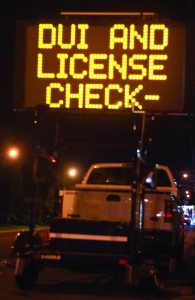
When you think of DUI checkpoints, you might imagine drunken drivers justly being taken off the road. However, a closer look at the actual practices of the Fresno Police Department (FPD) and public enforcement agencies around California show that the vast majority of offenders at checkpoints are not intoxicated drivers, but rather unlicensed drivers, many of whom are undocumented immigrants unable to obtain a license, to begin with.
When unlicensed drivers are caught at a checkpoint, their car is towed to one of more than 40 impound lots located around Fresno and held until all impound and towing fees are paid, often depriving them of their ability to get to work and subsequently provide for their families. This has sparked many critics to claim that checkpoints are being used to target immigrants and as cash generators, rather than to combat drunken driving.
On May 27, the California State Assembly passed the Allen Bill, or AB 1389, legislation that aims to combat police profiteering through the impoundment of unlicensed drivers’ vehicles by setting stricter guidelines for police procedures at DUI checkpoints. It is still awaiting a State Senate vote, but if passed it promises to restore the focus of checkpoints on catching drunk drivers and provides unlicensed drivers caught at checkpoints the opportunity to find a legal driver to avoid impoundment of their vehicle.
Perhaps no city could be more affected by this bill than Fresno. The FPD currently operates one of the largest DUI checkpoint programs in the country and even gained recognition for holding the most checkpoints of any municipality in the nation in 2009. However, that aggressive approach did not stop Fresno from having the 16th most alcohol-related automobile fatalities in the nation for the same year. Furthermore, at these checkpoints three times as many cars are towed than actual DUI arrests are made, raising allegations that checkpoints are being used more as cash generators than as a viable enforcement technique.

The FPD currently receives a referral fee of $40 per tow from the tow truck companies it hires, on top of any impoundment fees and fines. Through the first five months of this year, the FPD took in more than $3,336,600 from impoundment and towing referral fees, which is on track to nearly double last year’s income of $3,821,519 by year’s end. To put that in perspective, income this year from towing and impoundment is anticipated to be more than twice the budget of Fresno’s entire Public Works Department. This exemplifies one of the reasons that the Allen Bill was originally put forth.
As a supporter of the legislation, a retired San Diego County sheriff stated that the checkpoint system “was never intended to be used as a revenue-generating mechanism for municipalities, whose police departments have abused the law in writing these kinds of citations under the guise of a DUI checkpoint.”
The most common area for checkpoints from 2004 to 2008 was Tulare/Chestnut, followed by Ventura/R St. and Palm/Pinedale. Although these were the most repeated spots through the time period, on average they did not net a significant number more DUI arrests than other checkpoint locations. In pure numbers of DUI arrests, the FPD’s City-Wide Saturation and Bar Watch programs net a considerably higher amount of offenders.

However, the majority of regular checkpoints and the places at which checkpoints are most repeatedly held tend to be in minority neighborhoods, mostly in southern Fresno, fueling some to claim that the FPD targets these neighborhoods due to the assumed large populations of people who are unlicensed due to their undocumented status.
In the 2004–2008 time frame, there were about 255 checkpoints performed south of Shaw Avenue, while only 63 were north of it. In areas where checkpoints are most prevalent, the rate of Hispanics that are subject to police traffic stops is three times higher compared to Whites.
Knowing the risks involved, many undocumented drivers have reportedly resorted to buying “junker” cars, anticipating that if their car is towed they may not have the resources to pay the impoundment fees to retrieve it. However, that trend could change if the Allen Bill passes the State Senate because it stipulates that unlicensed motorists would have the opportunity to find a licensed driver to retrieve their vehicle to avoid its impoundment.

Of course, proponents of the current system of DUI checkpoints argue that undocumented unlicensed drivers are exactly that, unlicensed, and creating loopholes for these “criminals” puts other motorists in harm’s way. Many, like Sgt. Richard Tucker of the FPD, cite an AAA study called “Unlicensed to Kill,” which concluded that unlicensed drivers are 4.9 times more likely to be involved in a fatal crash.
Due to the fact that the study implies that motorists who are not properly educated and trained to drive are more dangerous on the road, some have suggested that this is part of the bigger issue of whether undocumented immigrants should be able to apply for driver’s licenses. In California, the right of an undocumented immigrant to obtain a license was protected until 1993 when lawmakers passed a bill requiring applicants to provide a Social Security number.
Some even voice a constitutional challenge to the very idea of DUI checkpoints. “Number five has no rights” has long been a saying among anti-DUI checkpoint activists. The slogan refers to police procedure, which is to stop the fifth car, or another preset number of cars, in the line at checkpoints, devoid of any probable cause. Some call this procedure a clear violation of their Fourth Amendment rights, which guard against unreasonable search and seizure. It was not until 1990 when the U.S. Supreme Court ruled on the issue in its controversial landmark case Michigan v. Sitz. As attorney Lawrence Taylor explains, “The Court overlooked the Constitution, focusing instead on the drunk driving problem.”
